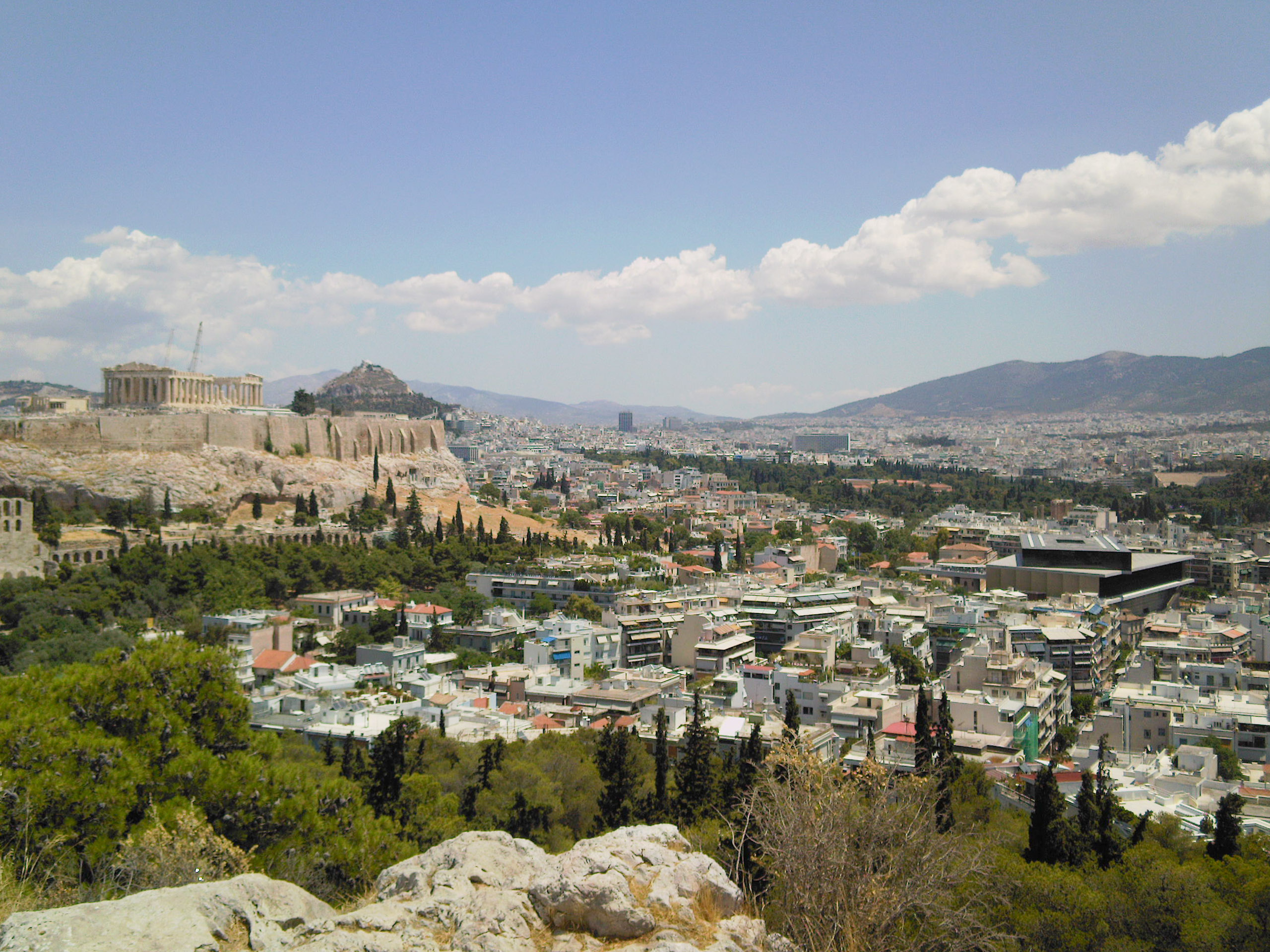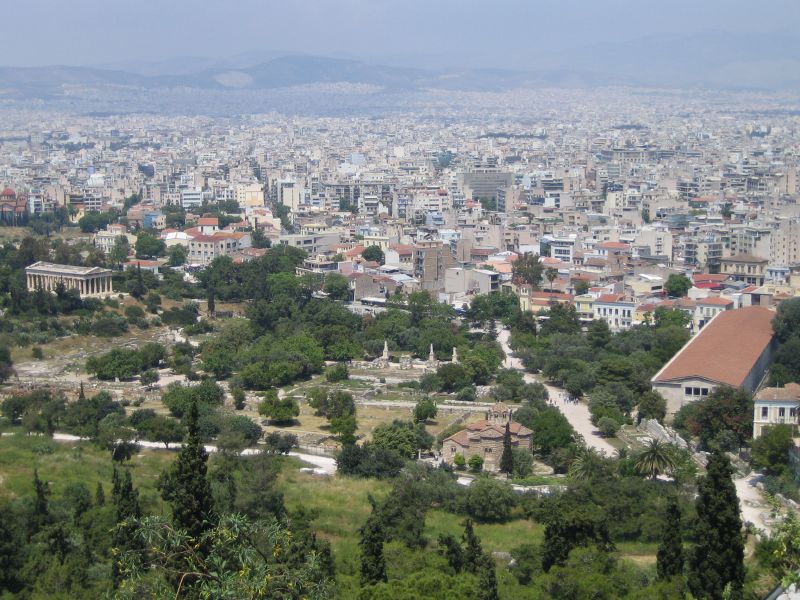|
Kritios
Kritios (, ) was an Athenian sculptor, probably a pupil of Antenor, working in the early 5th century BCE, whose manner is on the cusp of the Late Archaic and the Severe style of Early Classicism in Attica. He was the teacher of Myron. With Nesiotes (Νησιώτης,) Kritios made the replacement of the Tyrannicides ("Tyrant-killers") groupThe "Tyrant-killers" (Τυραννοκτόνοι), Harmodius and Aristogeiton, the heroic lovers who slew the tyrant Hipparchus. by Antenor, which had been carried off by the Persians in the first stage of the Greco-Persian Wars. The new group stood in the Agora of Athens and its composition is known from Roman copies. With Nesiotes Kritios made other statues, of bronze, dedicated on the Acropolis, of which only their inscribed bases remain to give testament. The head of a marble statue found on the Acropolis so much resembles the copies of one of the Tyrannicides – Harmodius – that it has been called the '' Kritios Boy'' (now in the Acr ... [...More Info...] [...Related Items...] OR: [Wikipedia] [Google] [Baidu] |
Severe Style
The Severe style, or Early Classical style, was the dominant idiom of Greek sculpture in the period ca. 490 to 450 BCE. It marks the breakdown of the canonical forms of archaic art and the transition to the greatly expanded vocabulary and expression of the classical moment of the late 5th century. It was an international style found at many cities in the Hellenic world and in a variety of media including: bronze sculpture in the round, stelae, and architectural relief. The style perhaps realized its greatest fulfillment in the metopes of the Temple of Zeus, Olympia. The term ''severe style'' was first coined by Gustav Kramer in his ' ("On the style and the origins of painted Greek pottery", 1837, Berlin) in reference to the first generation of red figure vase painters; since Vagn Poulsen's 1937 study ''Der strenge Stil'' ("The Severe Style"), the name has become exclusively associated with sculpture. Dating and relative chronology There is no firm chronology for the Severe s ... [...More Info...] [...Related Items...] OR: [Wikipedia] [Google] [Baidu] |
Contrapposto
( 'counterpoise'), in the visual arts, is a human figure standing with most of its weight on one foot, so that its shoulders and arms twist off-axis from the hips and legs in the axial plane. First appearing in Ancient Greece in the early 5th century BCE, ''contrapposto'' is considered a crucial development in the history of Ancient Greek art (and, by extension, Western art), as it marks the first time in Western art that the human body is used to express a psychological disposition. The style was further developed and popularized by sculptors in the Hellenistic and Imperial Roman periods, fell out of use in the Middle Ages, and was later revived during the Renaissance. Michelangelo's statue of ''David'', one of the most iconic sculptures in the world, is a famous example of ''contrapposto''. Definition ''Contrapposto'' was historically an important sculptural development, for its appearance marks the first time in Western art that the human body is used to express a more re ... [...More Info...] [...Related Items...] OR: [Wikipedia] [Google] [Baidu] |
Harmodius And Aristogeiton (sculpture)
A sculptural pairing of the tyrannicides Harmodius and Aristogeiton () was well known in the ancient world in two major versions but survives only in Roman marble copies. The lovers Harmodius and Aristogeiton were Athenian heroes whose act of daring in 514 BC opened the way for Athenian democracy. History A first version, commissioned from the sculptor Antenor following the establishment of Athenian democracy and erected in the Agora of Athens, was taken by the Persians during their occupation of the city in 480 BC and removed to Susa during the Greco-Persian Wars. Though it was returned to Athens by Alexander the Great (according to Alexander's historian Arrian) or by Seleucus I (according to the Roman writer Valerius Maximus), or again by Antiochus according to Pausanias (1.8.5), it never attracted copyists and is now lost. To replace the stolen original version, the Athenians commissioned Kritios and Nesiotes to produce a new statue, which was set up in 477/76 BC ... [...More Info...] [...Related Items...] OR: [Wikipedia] [Google] [Baidu] |
Acropolis Museum
The Acropolis Museum (, ''Mouseio Akropolis'') is an archaeological museum focused on the findings of the archaeological site of the Acropolis of Athens. The museum was built to house every artifact found on the rock and on the surrounding slopes, from the Greek Bronze Age to Roman and Byzantine Greece. The Acropolis Museum also lies over the ruins of part of Roman and early Byzantine Athens. The museum was founded in 2003 while the Organization of the Museum was established in 2008. It opened to the public on 20 June 2009. More than 4,250 objects are exhibited over an area of 14,000 square metres. History The first museum was on the Acropolis; it was completed in 1874 and underwent a moderate expansion in the 1950s. However, successive excavations on the Acropolis uncovered many new artifacts which significantly exceeded its original capacity. An additional motivation for the construction of a new museum was when the Greeks made requests for the repatriation of the Elgin Ma ... [...More Info...] [...Related Items...] OR: [Wikipedia] [Google] [Baidu] |
Kouros
Kouros (, , plural kouroi) is the modern term given to free-standing Ancient Greek sculpture, Ancient Greek sculptures that depict nude male youths. They first appear in the Archaic period in Greece and are prominent in Attica and Boeotia, with a less frequent presence in many other Ancient Greek territories such as Sicily. Such statues are found across the Greek-speaking world; the preponderance of these were found in sanctuaries of Apollo with more than one hundred from the sanctuary of Apollo Ptoion, Boeotia, alone. These free-standing sculptures were typically marble, but the form is also rendered in limestone, wood, bronze, ivory and terracotta. They are typically life-sized, though early Colossal statue, colossal examples are up to 3 meters tall. The female sculptural counterpart of the kouros is the kore (sculpture), kore. Etymology The Ancient Greek word kouros () refers to "youth, boy, especially of noble rank." When a pubescent was received into the body of grown men, ... [...More Info...] [...Related Items...] OR: [Wikipedia] [Google] [Baidu] |
Hipparchus (son Of Peisistratos)
Hipparchus (; died 514 BC) was a member of the ruling class of Athens and one of the sons of Pisistratus. He was a tyrant of the city of Athens from 528/527 BC until his assassination by the tyrannicides Harmodius and Aristogeiton in 514 BC. Life Hipparchus was said by some Greek authors to have been the tyrant of Athens, along with his brother Hippias, after the death of their father Peisistratos in about 528/7 BC. The word ''tyrant'' literally means "one who takes power by force", as opposed to a ruler who inherited a monarchy or was chosen in some way. It carried no pejorative connotation during the Archaic and early Classical periods. However, according to Thucydides, Hippias was the only 'tyrant'. Both Hipparchus and his father Pisistratus enjoyed the popular support of the people. Hipparchus was a patron of the arts; it was he who invited Simonides of Ceos to Athens. In 514 BC, Hipparchus was assassinated by the tyrannicides, Harmodius and Aristogeito ... [...More Info...] [...Related Items...] OR: [Wikipedia] [Google] [Baidu] |
Neoclassical Sculpture
Neoclassicism, also spelled Neo-classicism, emerged as a Western cultural movement in the decorative and visual arts, literature, theatre, music, and architecture that drew inspiration from the art and culture of classical antiquity. Neoclassicism was born in Rome, largely due to the writings of Johann Joachim Winckelmann during the rediscovery of Pompeii and Herculaneum. Its popularity expanded throughout Europe as a generation of European art students finished their Grand Tour and returned from Italy to their home countries with newly rediscovered Greco-Roman ideals. The main Neoclassical movement coincided with the 18th-century Age of Enlightenment, and continued into the early 19th century, eventually competing with Romanticism. In architecture, the style endured throughout the 19th, 20th, and into the 21st century. European Neoclassicism in the visual arts began in opposition to the then-dominant Rococo style. Rococo architecture emphasizes grace, ornamentation ... [...More Info...] [...Related Items...] OR: [Wikipedia] [Google] [Baidu] |
Ancient Agora Of Athens
The ancient Agora of Athens (also called the Classical Agora) is an ancient Greek agora. It is located to the northwest of the Acropolis, and bounded on the south by the hill of the Areopagus and on the west by the hill known as the Agoraios Kolonos, also called Market Hill. The Agora's initial use was for a commercial, assembly, or residential gathering place. Buildings and structures of the classical agora North side of the agora * Stoa Poikile (Painted stoa), a building built in the 5th century B.C. used purely for socialising unlike many other buildings in the agora. * Altar of the Twelve Gods * Stoa Basileios (Royal stoa) * Temple of Aphrodite Urania *The south end of what is believed to be a Basilica has been uncovered near Hadrian Street and is dated to the mid 100s C.E. East side of the agora * The Stoa of Attalos, a stoa lined with shops built in the 2nd century B.C. which has since been reconstructed for use as the Museum of The Ancient Agora. * The Square ... [...More Info...] [...Related Items...] OR: [Wikipedia] [Google] [Baidu] |
Acropolis Of Athens
The Acropolis of Athens (; ) is an ancient citadel located on a rocky outcrop above the city of Athens, Greece, and contains the remains of several Ancient Greek architecture, ancient buildings of great architectural and historical significance, the most famous being the Parthenon. The word ''Acropolis'' is . The term acropolis is generic and there are many other acropoleis in Greece. During ancient times the Acropolis of Athens was also more properly known as Cecropia, after the legendary serpent-man Cecrops I, Cecrops, the supposed first Athenian king. While there is evidence that the hill was inhabited as early as the 4th millennium BC, it was Pericles (–429 BC) in the fifth century BC who coordinated the construction of the buildings whose present remains are the site's most important ones, including the Parthenon, the Propylaia_(Acropolis_of_Athens), Propylaea, the Erechtheion and the Temple of Athena Nike. The Parthenon and the other buildings were seriously damaged during ... [...More Info...] [...Related Items...] OR: [Wikipedia] [Google] [Baidu] |
Athenian
Athens ( ) is the Capital city, capital and List of cities and towns in Greece, largest city of Greece. A significant coastal urban area in the Mediterranean, Athens is also the capital of the Attica (region), Attica region and is the southernmost capital on the European mainland. With its urban area's population numbering over 3.6 million, it is the List of urban areas in the European Union, eighth-largest urban area in the European Union (EU). The Municipality of Athens (also City of Athens), which constitutes a small administrative unit of the entire urban area, had a population of 643,452 (2021) within its official limits, and a land area of . Athens is one of the List of oldest continuously inhabited cities, world's oldest cities, with its recorded history spanning over 3,400 years, and its earliest human presence beginning somewhere between the 11th and 7th millennia BCE. According to Greek mythology the city was named after Athena, the ancient Greek goddess of wisdom, ... [...More Info...] [...Related Items...] OR: [Wikipedia] [Google] [Baidu] |


